Livestock manure is a potential source of surface and groundwater contamination. Modern livestock production, confining herds in smaller spaces, has increased problems associated with disposing and making use of manure. Properly handled and used, manure may be an asset; otherwise, it is a liability. Spreading manure on land recycles nutrients and replaces much commercial fertilizer. It increases the fertility and water-holding capacity of the soil and also improves soil tilth, bulk density, infiltration rate and permeability. Collecting, storing, hauling and applying manure to fields generally represents net production costs, but is usually the least-cost system for livestock manure utilization.
Missouri swine manure management can be classified into three systems, solid (including semisolid), slurry, or liquid (lagoon) (Figure 1), depending on the method of collection, storage, transportation and the distribution of the manure onto the fields. The solids content of these systems depends on the amount of bedding or water dilution used by a specific operation. Swine manure, as excreted (feces + urine), is approximately 10 percent solids and can be classed as a slurry; it can be pumped with centrifugal pumps designed for slurry material. Open-impeller centrifugal pumps can handle slurry manure with up to 15 percent solids content. Solid manure contains enough bedding material, or has received enough air drying, to raise the solids content to where it will stack with little or no seepage. It is best handled with a front-end loader. Semisolid manure will stack but has a lower profile than solid manure, and seepage may collect around the outer edge. It can be pumped with positive-displacement pumps or be handled with a front-end loader. Lagoon effluent (liquid manure) is usually diluted with enough water to permit easy pumping with conventional centrifugal irrigation-type pumps. Normally, fibrous material such as chopped straw or waste hay is not present.
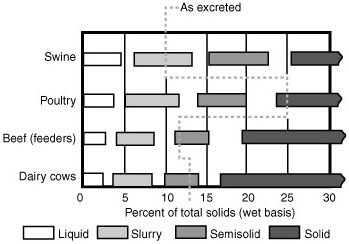 Figure 1
Figure 1
Relative handling characteristics of different types of manure.
As swine operations moved to confinement, many used more than one manure management system. Typically, the farrowing and nursery units were the first to move to confinement systems, where the manure is stored in a pit and handled as a slurry, or stored in a lagoon and handled as a liquid. The manure from finishing hogs and gestating sows was often handled as a solid during the transition period. Most newer swine facilities use either a liquid system or a slurry system, although some new systems use the "hoop structure" with bedding, which results in solid manure. In a pasture system, most of the manure may be spread by the animals.
Land application and regulations
To minimize the potential for both air and water pollution and to maximize nutrient recovery, livestock manure should be incorporated into the soil as soon as possible after application. To prevent applying an excess of plant nutrients (nitrogen, phosphorus and potassium), long-term records should be kept on the amount applied to each field. An analysis should be made to determine the nutrient content of the manure, and a good measurement of the amount of manure applied is also necessary. The amount of land required for manure application is usually based on the number of pounds of nitrogen or phosphorous removed per acre annually by plant production. There are several methods of determining nutrient requirements. When determining ideal manure nutrient requirements in the field, consideration needs to be given to data from manure nutrient analysis, soil tests, crop yield and plant tissue analysis.
Solid, slurry and lagoon systems, or a combination, can be developed to meet Missouri Clean Water Law requirements. Consult local health and regulatory authorities and have all plans approved before constructing any manure handling system. A swine operation with 2,500 head or more weighing over 55 pounds, or 15,000 nursery pigs under 55 pounds, or the equivalent, is required to obtain a construction and operating permit from the Missouri Department of Natural Resources. Smaller systems, which do not require regulatory permits, should be designed and constructed to the same standards and specifications as a permitted system. Any livestock manure management system, regardless of size, must be designed and operated in a manner that does not pollute ground or surface water.
The state of Missouri has passed an environmental law that classifies confined animal feedlot operations based on size in "animal units." The required buffer distance for each class is shown in the following table. The buffer distance is from the facility to any public building or "non-owned," occupied dwelling, a dwelling not owned by the feedlot operation.
| Class | Animal units | Head of swine | Buffer distance |
|---|---|---|---|
| Class IA | 7,000 AU* | 17,500 head** | 3,000 feet |
| Class IB | 3,000 to 6,999 AU | 7,500 to 17,499 head | 2,000 feet |
| Class IC | 1,000 to 2,999 AU | 2,500 to 7,499 head | 1,000 feet |
| Class II | 300 to 999 AU | 750 to 2,499 head |
* An animal unit is based on the amount of manure excreted by a 1,000-pound beef animal. By Missouri DNR rules, 2.5 swine weighing over 55 pounds or 15 swine weighing between 10 and 55 pounds equals one animal unit.
** Numbers in this column are for the number of swine weighing over 55 pounds in each class.
Contact the Technical Assistance Program (TAP) at the Missouri Department of Natural Resources at 800-361-4TAP or your local MU Extension or Natural Resources Conservation Service office for information about permits and assistance in planning manure management systems.
Manure nutrient losses by system
Manure nutrient losses vary widely depending on such factors as storage time, treatment method and time elapsed between land application and incorporation, as shown in Tables 1 and 2.
Table 1
Percent of original nutrient content of swine manure retained by various management systems.
| Management system | Nitrogen (N) | Phosphorus (P) | Potassium (K) |
|---|---|---|---|
| Manure stored in an open lot in cool, humid region | 55 to 70 | 65 to 80 | 55 to 70 |
| Manure liquids and solids stored in a covered, watertight structure | 75 to 85 | 85 to 95 | 85 to 95 |
| Manure liquids and solids stored in an uncovered, watertight structure | 70 to 75 | 80 to 90 | 80 to 90 |
| Manure stored in pits beneath slatted floor | 70 to 85 | 90 to 95 | 90 to 95 |
| Manure treated in an anaerobic lagoon or stored in manure storage pond after being diluted more than 50 percent | 15 to 30 | 35 to 50 | 50 to 60 |
Source
Agricultural Waste Management Field Handbook, Table 11-5 and Midwest Plan Service, MWPS18, Table 10-1.
Note
Phosphate (P2O5) = 2.29 x P; potash (K2O) = 1.21 x K.
Table 2
Percentage of nitrogen in applied manure available to the soil. (Ammonia volatilization causes the predicted losses.)
| Application method | Applied nitrogen available to plants | ||
|---|---|---|---|
| Injection | 95 percent | ||
| Irrigation | 60 to 85 percent | ||
| Broadcast (fresh solids) | |||
| Days between application and incorporation | Warm dry soil | Warm wet soil | Cool wet soil |
| 1 | 70 | 90 | 100 |
| 4 | 60 | 80 | 95 |
| 7 or more | 50 | 70 | 90 |
Source
Agricultural Waste Management Field Handbook, Table 11-6 and Midwest Plan Service, MWPS18, Table 10-2.
Solid manure systems
Most older facilities with concrete floors employ solid manure handling. Solids may be scraped and hauled to a field or stockpiled for later hauling when land for application is available or when field conditions permit. Manure with 75 to 80 percent moisture content can usually be handled as a solid. Swine manure, as excreted, contains about 91 percent water.
The consistency of solid manure will vary with the amount of bedding incorporated into the manure or the amount of drying that occurs before hauling. Addition of 15 pounds of dry wheat straw per 100 pounds of fresh manure (equivalent to about 5 pounds of straw per day per sow and litter) is needed to permit handling swine manure as a solid. Solid handling systems using minimal amounts of bedding and with most of the liquid evaporated, or drained off to a soil-plant filter or liquid storage, minimize the volume and weight of manure to be transported to fields and spread.
Deep-litter systems in hoop structures
A recent development in solid manure management for swine is the "hoop structure" or "deep litter" concept. In this system, hogs are confined on a layer of absorbent material such as sawdust, ground corn stalks, or other fibrous material. Manure deposited in the 18-inch-deep layer is mixed by animal activity and absorbed. Some composting may occur within the deep litter. The mixture of manure and bedding is removed and spread on fields as a solid, and a new layer is placed in the building after each group of hogs is marketed. Bedding use in hoop structures is about 200 to 300 pounds of bedding per finishing pig. No lagoon or management of liquids is required with this approach, so that manure can be handled entirely in the solid form. Another perceived advantage is lower capital cost for the confinement facility. Disadvantages include somewhat compromised animal performance (lower feed efficiency, lean carcass characteristics) when compared with performance in a traditional confinement building. Thus far, use of this system has been limited to small producers.
Scraping systems
Manure from bedded housing usually has to be handled as a solid. As a semisolid, manure can be scraped into a holding area where liquids are allowed to drain off. Scraping can be done by hand, by tractor-mounted blades, or by gutter scrapers pulled by cables or chains. In Missouri, small tractors with front- or rear-mounted blades and skid-steer loaders are commonly used for mechanically scraping manure. Tractor scrapers function better in cold weather and tend to be more dependable than gutter scrapers.
Loaders
Front-end tractor loaders (Figure 2) can remove manure from large areas with high clearances. Traction and stability can be a problem, although wide front axles can improve stability, and weights on the rear wheels or front-wheel-assist can improve traction. Skid steer loaders can work in cramped quarters and, in general, lessen time and hand labor expended.
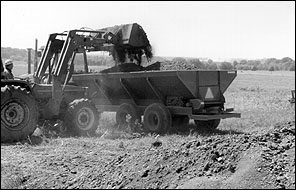 Figure 2
Figure 2
Tractor with front loader moves solid manure to a spreader.
Manure spreaders
Most solid manure spreaders have moving apron chains to move the load rearward to beaters. Flail-type spreaders have chains attached to a shaft that revolves at high speed to sling the manure out of the tank. Flail-type spreaders are also suited for semisolid manure.
Manure storage
Storage is required with most solid handling systems because of weather or limited available fields. A 120-day minimum storage capacity is recommended. The storage area should have all-weather access with surface runoff water diverted from the storage area. Any draining liquid should be directed to a soil-plant filter, lagoon or holding pond. A roof can eliminate the need for collecting and storing runoff from the storage area.
Slurry manure systems
Slurry systems were more commonly used during the early transition period from pastures and open lots to total confinement. Slurry systems maximize recovery of plant nutrients from manure and are often used where geological conditions are unsuitable for a lagoon system. The volume of manure handled with slurry systems is greater than with solid systems because of the higher water content (6 to 13 percent solids), but slurry systems allow the manure to be handled as a fluid. Normally, bedding is not used with slurry systems.
Slurry systems may have deep-pit storage under the building or shallow pits with pull-plug flushing or scrapers to move manure to outside storage, either in tanks (concrete or metal) or in earthen basins. Scraped systems tend to produce higher odor levels in buildings than slatted systems in which manure is submerged in water.
Swine slurry is usually transported in tank wagons or pumped through pipes or hoses to tractor-drawn injectors or large-gun irrigators. Agitation is required during the emptying process to remove settled solids when the manure is collected and stored in pits.
Agitation of pits under occupied buildings may cause death of animals (and people) unless ventilation rates are increased to prevent the buildup of lethal levels of hydrogen sulfide. It can kill swine or humans in a few breaths, and humans cannot detect high concentrations.
Characteristics
Slurry manure usually contains 87 to 94 percent moisture content and can be handled as a fluid but may require special pumps. Manure with 96 to 98 percent water content can be handled with ordinary pumps and flushing equipment if excessive straw or fibrous material is not present. For conventional pumping, 1.25 gallons of water must be added to dilute a gallon of fresh swine manure to 96 percent moisture content. This more than doubles the volume of manure to be stored and transported.
Slurry systems are designed to minimize dilution, thus making it possible to use tank wagons for transportation and application. Efforts should be made to minimize unnecessary addition of water (from wash water, leaky waterers and rain water). Hauling extra water with a slurry system is not practical. Flushing is not suited to a slurry manure management system.
For example, assume twenty-four 375-pound sows and their litters of pigs produce 96 gallons of undiluted manure per day. Hauling their yearly waste output will require 12 trips to the field with a 3,000-gallon tank wagon. If manure is diluted to 4 percent solids, 26 trips per year will be required.
Slurry manure storage
Slurry can be stored in earthen basins, below-ground and above-ground concrete tanks and either lined or unlined metal tanks. A 180-day minimum storage capacity is recommended. In some locations, soil type can prohibit the use of earthen basins or require the use of a membrane-type liner. In these locations, concrete or steel manure storage tanks may be used. Consider using a cover to prevent additional rainfall from entering the structure.
Depending on the location of buildings and lots, it may be possible to gravity drain or scrape manure into the storage structure. In-ground tanks must be designed to resist lateral forces from the soil when the tank is empty. Outside drainage is usually required to prevent the tank from floating when it is empty and the soil is saturated. Most above-ground tanks have the added expense of a dedicated pump to transfer manure in and out of the facility.
Earthen basins
Earthen basins are usually partially below the original grade and partially above. Berms should be constructed to divert surface runoff water from the basin. Check with the Natural Resources Conservation Service and the Missouri Division of Geology and Land Survey for suitable sites, soil suitability and construction details to prevent seepage from polluting ground or surface water. Earthen basins must be constructed with a clay seal (on the bottom and sides) conforming with CWC (Clean Water Commission) rules to prevent leakage. In some cases, an artificial liner may be required. If the site has a high potential for a subsurface collapse, the Missouri Department of Natural Resources will not approve an earthen manure storage structure. In these cases, an alternate storage site must be selected, or a concrete or steel tank must be used.
Scrape to storage
Scraping into below-ground storage areas can reduce equipment investment and maintenance costs. Any system that involves uncovered concrete lots, alleys or exercise areas increases the amount of runoff water that is hauled. Above-ground tanks require scraping into a collection pit and then pumping.
Pumps
Pumps are frequently used to move manure into tanks and to move manure from tanks into tank wagons. High-capacity pumps (1,000 to 3,000 gallons per minute) are used to remove swine manure from storage, with extra capacity for agitation to mix solids and liquids (Figure 3).
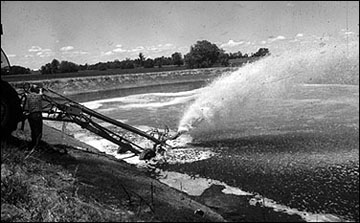 Figure 3
Figure 3
High-capacity pumps can be used to agitate slurry pits and lagoons.
Tank wagons
Tractor-drawn tank wagons have capacities from 1,000 to 10,000 gallons. For long hauls or large operations, a tank truck may be more economical. Tank wagons can either spread the liquid on the soil or be equipped with knives or disks to inject or to incorporate the slurry into the soil. Injection reduces odors and nitrogen loss but requires considerable power to pull the tank wagon and injectors at a reasonable speed.
Injection cannot be done when the soil is frozen or if it is too rocky. Likewise, spreading manure on frozen soil could pollute surface water if rain or snow occurs while the ground is still frozen. Therefore, spreading manure on frozen ground is prohibited by the Missouri Department of Natural Resources.
Slurry manure systems require more land for application than lagoon systems because more plant nutrients are retained. In Missouri, about five times as much land is usually required for slurry systems than for lagoon systems.
Drag-hose injectors and incorporators
Tractor-drawn drag-hose injectors (Figure 4) and incorporators (Figure 5) reduce the odor and nitrogen volatilization from land application of slurry and lagoon effluent. These units are becoming more common in Missouri and are often owned by custom operators.
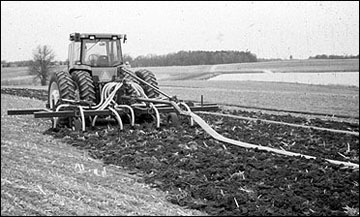 Figure 4
Figure 4
Tractor-drawn drag-hose injectors reduce the odor and nitrogen volatilization associated with land application of manure.
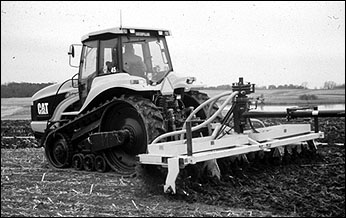 Figure 5
Figure 5
Tractor-drawn drag-hose incorporators and injectors are commonly owned by custom operators.
Lagoon manure systems
Many swine operations employ a lagoon (liquid) system, either with a flush system or with a "pull-plug" system, for transporting the manure to a lagoon for storage/treatment. Lagoons are applicable where flushing is desired or where significant amounts of lot runoff must be contained. Swine lagoon effluent usually contains less than 2 percent solids. Swine manure containing less than 4 percent solids may be classified as a liquid and can be handled by conventional pumps, pipes and irrigation systems to minimize the labor involved in transporting and applying the manure to the land (soil-plant filter) to be used by crops.
Characteristics
Lagoon systems handle highly diluted manure (96 percent or more water) that can be pumped through irrigation systems. Most unagitated lagoon effluent is more than 99 percent water.
Flushing or pull-plug is the preferred method of manure collection and transportation for many Missouri swine producers because it eliminates the labor required for scraping and transporting manure to storage. Lagoons complement these systems because they provide storage at relatively low cost and provide a source of recycle water. Fresh water flushing should be used only if the system is so designed.
The anaerobic treatment of manure usually results in acceptable odor levels when lagoons are properly designed, located, constructed and managed. Odor problems from land application of anaerobic lagoon liquids by irrigation can be held to a minimum by choosing the proper time to make the application.
As shown in Table 1 for lagoons, 70 to 85 percent of the estimated input nitrogen can be lost in a lagoon, but this can be an advantage if limited land is available for manure disposal. The amount of nitrogen available from the lagoon can vary widely depending on such factors as storage time, time of year and dilution by rainfall. For large operations, lagoons provide the least-cost alternative for storage on a per-animal basis. Consideration should be given to separating fibrous material (if bedding is used) from the manure going to the lagoon. Experience has shown that excessive amounts of this material can build up as a surface crust and increase the rate of sludge accumulation in the lagoon, thus decreasing the lagoon's long-term effectiveness as a waste storage and treatment facility.
Lagoons are usually designed for a 365-day storage capacity with all manure going into the lagoon. This includes manure from gestating sows and replacement gilts. Also note that lagoons are not allowed by Missouri DNR in areas where subsurface collapse potential is high.
Lagoons are usually formed by excavation and above-ground berms. The berms divert surface runoff water from the lagoon, but a diversion channel may be required. A clay seal (compacted by a sheepsfoot roller to meet DNR requirements) must be applied to the bottom and sides. Also, lagoons must be filled with fresh water to the minimum operating level and the berms seeded and mulched before operation. The minimum design volume increases from south to north Missouri.
Pumps
Conventional irrigation pumps are adequate for pumping lagoons if the intake is floated about 1 to 2 feet below the surface. The floating intake prevents surface debris interference and reduces the handling of sludge.
Centrifugal power-takeoff irrigation pumps are a practical alternative for irrigating from lagoons. Small engine-mounted, low-lift pumps can also provide adequate capacity and pressure to pump a small lagoon.
Land application by irrigation
A complete manure management system includes methods of spreading manure in a pollution-free manner. It is important that all irrigation systems be monitored while liquid manure is being applied so no runoff occurs at the application site.
Surface irrigation systems
Uniform application is essential to proper fertilizer use. Design for cutback (high initial flow to get the water across the field fast, then reduce the flow rate) or use a "clean water" presoak or use surge irrigation valves to get even application. Gated pipe can provide a low-cost distribution system for pumping small lagoons, especially where uniform application is not critical. Small systems can use a "homemade" gated pipe made from polyethylene pipe (e.g., using 2-inch-diameter pipe for 50 gpm systems) with holes in the pipe at 30- to 40-inch intervals. The holes must be small enough that flow is distributed out of all of the holes, but large enough that they do not become clogged by small solids. These systems are feasible for small lagoons but have been used for larger lagoons. For larger systems, commercial gated pipe with adjustable gates is an alternative.
Sprinkler irrigation systems
For irregular rolling land, use a sprinkler irrigation system instead of gated pipe. Various sprinkler systems are suitable; the choice depends on the desire to save labor or money.
Stationary hand-carried systems
For small operations, one or more small sprinklers fed by 3-inch to 6-inch portable pipe is adequate if time and labor are available. For even smaller operations, a 1/2- to 1-inch nozzle sprinkler, covering 1/2 to 2 acres per set, can be used. For larger operations, a high-volume gun sprinkler with a 1- to 2-inch nozzle, covering 2 1/2 to 6 acres per set, can be used to reduce the amount of labor required. These guns can also be used for applying slurry.
Moving-sprinkler systems
To reduce labor and to accommodate larger operations, a traveling gun (Figure 6) or a center-pivot irrigator may be more cost-effective than hand-moved sprinklers. Different models of the small traveling guns are now available. Larger traveling guns, used for crop irrigation, can be used if crops are irrigated conventionally or if rental units are available. Missouri has several custom lagoon pumpers with traveling guns.
 Figure 6
Figure 6
Traveling guns are the usual means of irrigating lagoon effluent onto fields.
For further information
- Agricultural Waste Management Field Handbook. Part 651, National Engineering Handbook. Washington, D.C.: Natural Resources Conservation Department, U.S. Department of Agriculture, 1992.
- American Society of Agricultural Engineers. 1997. "Control of Manure Odors." ASAE Standards. ASAE, St. Joseph, Mich.
- American Society of Agricultural Engineers. 1999. "Manure Production and Characteristics." ASAE Standards. ASAE, St. Joseph, Mich.
- American Society of Agricultural Engineers. 1998. "Manure Storages." ASAE Standards. ASAE, St. Joseph, Mich.